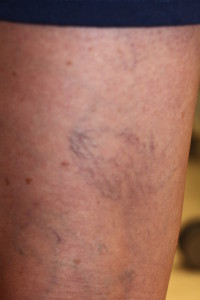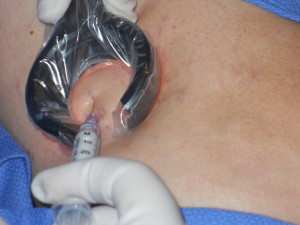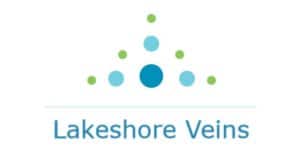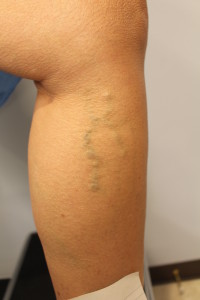Varicose Veins Treatment – Part 2
 Our vein and laser clinic is here to educate you on varicose and spider vein treatments. The last blog covered the evaluation, diagnosis and ultrasound mapping of varicose veins and how that mapping helps guides treatments. This weeks blog will go in to greater detail on treating your varicose veins.
Our vein and laser clinic is here to educate you on varicose and spider vein treatments. The last blog covered the evaluation, diagnosis and ultrasound mapping of varicose veins and how that mapping helps guides treatments. This weeks blog will go in to greater detail on treating your varicose veins.
A first step for all people suffering from varicose veins is to maximize conservative care. Conservative care includes use of compression stockings, exercise, leg elevation and lifestyle modification including losing weight, limiting salt and avoiding prolonged periods of sitting or standing. Conservative care will help with prevention and symptom management, but is unlikely to get rid of already existing varicose veins. So to get rid of varicose veins, you will likely need a procedure and exactly what procedure or group of procedures will depend on your vein mapping. Several years ago, varicose vein surgery in the form of stripping was predominantly performed. Today, high ligation and stripping is rarely performed as the recovery is long and there are many more minimally invasive options available.
If your vein problem is superficial involving vessels on the skin, or just under the skin and measure 2-3 mm in diameter, sclerotherapy is your best option. Sclerotherapy involves injecting a chemical into the blood vessel causing the vessel to close. Eventually your body will resorb the vessel and it will no longer show. At Lakeshore Veins, we use polidocanol (Asclera) and Sotradecol, both detergents and FDA approved agents for sclerotherapy. Sclerotherapy is unlikely to get rid of all of your spider veins, but hopefully will make your legs look good enough to feel comfortable in shorts or a skirt again. Skin laser treatments are also occasionally used. However, skin laser is not very effective on larger vessels or on darker skin. Skin laser is most effective on facial spider veins where the skin is thin and the vessels are small.
 If you have larger, ropey varicosities, you will likely need a combination of therapies to treat the vessels. These vessels are usual caused by a vessel deeper to the skin with non functioning valves. This feeding vessel, usually the Great or Small Saphenous Vein, is treated by occluding the vessel. Occluding this feeding vessel is necessary because if left untreated, the treated superficial vessels will return – much like leaving the roots of a weed. Occluding the feeding vessel can be accomplished with Laser Vein Ablation (EVLT), Radiofrequency Ablation (Venefit Procedure), balloon sclerotherapy or glue. The two with the most US experience are laser vein ablation and radiofrequency ablation. Both laser vein ablation and radiofrequency ablation are heat sources which sear the vessel closed. To perform the procedure, your physician will numb your skin and then place a small working tube through the skin into the faulty blood vessel. The laser or radiofrequency catheter is advanced under ultrasound to the junction with the deep vein either at your groin or knee. Several more numbing injections are required to collapse the vein to be treated, to insulate the surrounding tissues and to make sure you do not feel the procedure. The catheter is then pulled back over approximately 5 minutes time closing the vessel. Which procedure is right for you depends on the preference of your treating physician, the size of your vessel, the depth to the skin and the tortuosity of your vessel.
If you have larger, ropey varicosities, you will likely need a combination of therapies to treat the vessels. These vessels are usual caused by a vessel deeper to the skin with non functioning valves. This feeding vessel, usually the Great or Small Saphenous Vein, is treated by occluding the vessel. Occluding this feeding vessel is necessary because if left untreated, the treated superficial vessels will return – much like leaving the roots of a weed. Occluding the feeding vessel can be accomplished with Laser Vein Ablation (EVLT), Radiofrequency Ablation (Venefit Procedure), balloon sclerotherapy or glue. The two with the most US experience are laser vein ablation and radiofrequency ablation. Both laser vein ablation and radiofrequency ablation are heat sources which sear the vessel closed. To perform the procedure, your physician will numb your skin and then place a small working tube through the skin into the faulty blood vessel. The laser or radiofrequency catheter is advanced under ultrasound to the junction with the deep vein either at your groin or knee. Several more numbing injections are required to collapse the vein to be treated, to insulate the surrounding tissues and to make sure you do not feel the procedure. The catheter is then pulled back over approximately 5 minutes time closing the vessel. Which procedure is right for you depends on the preference of your treating physician, the size of your vessel, the depth to the skin and the tortuosity of your vessel.
Once the feeding vessel is occluded, the superficial varicosities may gradually go away or may need to be treated with either sclerotherapy – this time using ultrasound guidance, or with microphlebectomy. Microphlebectomy is a technique where the superficial vessel is removed through tiny 2 mm nicks in the skin. Many people look at those rope-like varicosities and wonder how they can be removed through such a small incision. Remember, the blood supply has been cut off, therefore removing the vein is like removing a deflated balloon.
At Lakeshore Veins we encourage you to discuss any treatment plan with your treating physician. There are many good ways to treat your varicose and spider veins. We call these treatments procedures rather than surgery as they are much less invasive. At our vein clinic we will work with you to treat your vein disease in the least invasive and most comfortable fashion available. Learn more about vein treatments without surgery – schedule your free screening with Dr. Anne Bartel today! (262) 241-3999.




